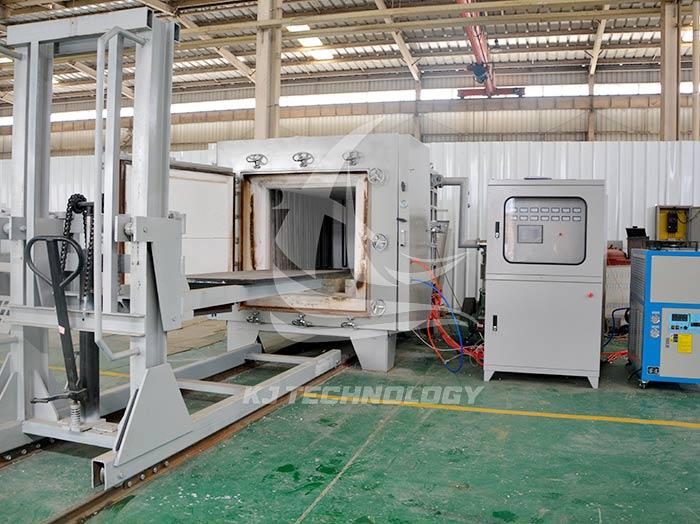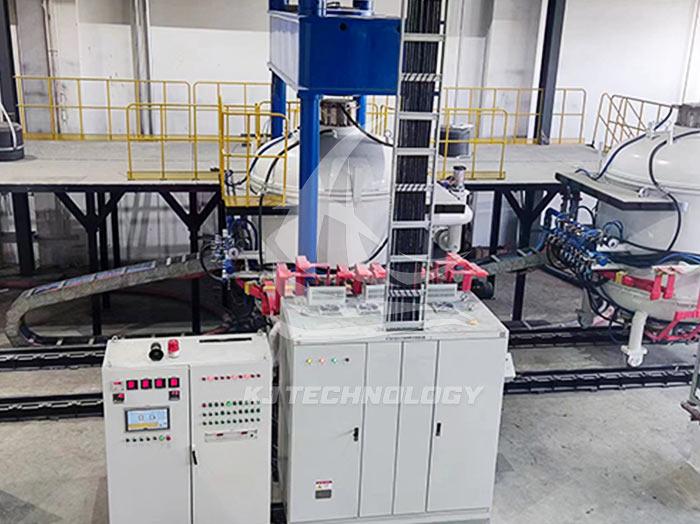Common faults and troubleshooting methods of vacuum hot pressing furnace
 07-07-2025 Author: KJ technology
07-07-2025 Author: KJ technology
The common faults and troubleshooting methods of vacuum hot pressing furnace are as follows:
1. Vacuum system malfunction
Low vacuum degree or inability to draw vacuum
Possible reasons:
Vacuum pump oil pollution, insufficient or too thin;
The exhaust filter is clogged;
There are leakage points in the equipment (such as solenoid valves, pipe joints, vacuum pump suction valves, working chamber gaskets, etc.);
High vacuum gauge or diffusion pump oil aging;
The furnace door is not tightly sealed (the sealing ring is aged, damaged, or contaminated with foreign objects).
Exclusion method:
Clean the vacuum pump and replace it with new oil;
Clean or replace the exhaust filter;
After evacuating, turn off the power, check the leakage point and repair it;
Replace the vacuum gauge or diffusion pump oil;
Check the sealing ring of the furnace door, clean any foreign objects, and apply vacuum grease.
Vacuum pump has loud noise or fuel injection
Possible reasons:
Wear or rupture of vacuum pump coupling;
The O-ring of the suction valve has come off;
The rotary blade is worn.
Exclusion method:
Replace the coupling;
Reinstall the O-ring of the suction valve;
Replace the rotor.
2. Temperature system malfunction
High temperature alarm
Possible reasons:
Abnormal temperature controller parameters;
Solid state relay is broken down;
Poor contact of thermocouple probe.
Exclusion method:
Proofreading temperature controller parameters;
Measure the output resistance of the solid-state relay with a multimeter, and replace it if it is broken down;
Gently shake the thermocouple probe. If the temperature controller shows a large jumping amplitude, replace the thermocouple.
The temperature display is too low or cannot reach the set value
Possible reasons:
Abnormal temperature controller parameters or no output signal;
Thermocouple damage;
The heating tube is not powered or aging;
The resistance value of the heater increases.
Exclusion method:
Check the temperature controller parameters and adjust them;
Swap thermocouples for testing, replace if damaged;
Use a test pen to test the wire connecting the heating tube. If there is electricity, measure the current. If there is no electricity, check the circuit;
According to the instrument manual, increase the output power and replace the heater when it is severely aged.
3. Mechanical structural failure
The furnace door cannot be tightly closed
Possible reasons:
The hinges of the door are loose;
Buckle deformation;
The sealing strip at the door is damaged or the door panel is deformed.
Exclusion method:
Tighten the hinge;
Repair or replace the buckle;
Replace the sealing strip or adjust the door panel.
Fan abnormal noise
Possible reasons:
Foreign objects enter the fan rotor;
The screws securing the motor are loose.
Exclusion method:
Clean up foreign objects inside the fan rotor;
Tighten the screws of the motor.
4. Pneumatic system malfunction
Pneumatic valve cannot operate
Possible reasons:
Electromagnetic valve malfunction;
Insufficient compressed air pressure;
The pneumatic valve itself is damaged.
Exclusion method:
Check if the solenoid valve is working properly;
Adjust the compressed air pressure to the normal range (0.4-0.6 MPa);
Replace the pneumatic valve.
Poor ventilation in the pressurized air path
Possible reasons:
Air path blockage or bending.
Exclusion method:
Streamline and unblock the pressurized air path.
5. Other faults
The over temperature alarm light is on
Possible reasons:
Overheating of furnace temperature;
The instrument settings are incorrect.
Exclusion method:
Reset the over temperature alarm parameters according to the instructions.
Heating does not stop
Possible reasons:
Poor contact or burnout of the heating time relay.
Exclusion method:
Adjust the contact between the time relay and the socket or replace it.








